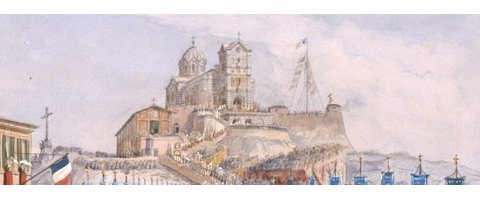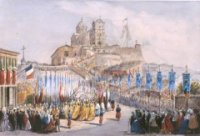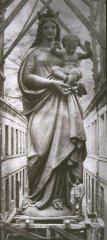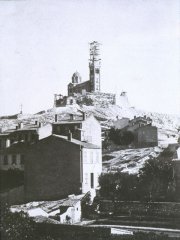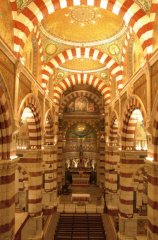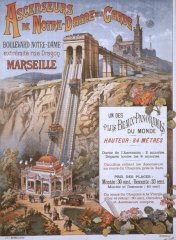The directors of Notre-Dame de la Garde asked the architects to draw up the plans of the new sanctuary. They had to choose between two projects: a church of neo-gothic style and a church of neo-roman style. It was the second project that was selected. And, because the basilica was decorated later with mosaics of byzantine inspiration, one usually calls it romano-byzantine. Its architect was Jacques Henri Espérandieu : he was then only 23 years old … and he was of the Protestant faith.
-


- Etat de la construction en 1861 – Le bâtiment de gauche est la chapelle provisoire construite en 1855.
The first stone was laid on September 11th 1853 by the Bishop of Marseilles, Mgr Eugène de Mazenod. The faithful made donations to finance the construction. But, during the early years, money often grew short and, on several occasions, work had to be interrupted. After 8 years work on the site, on the death of Mgr de Mazenod in 1861, they had finished excavating the crypt in the rock, but, of the church above, only the side-walls and the base of the bell-tower had been built. So there remained to be built the vault of the nave, the dome and most of the tower. Work was speeded up by the successor of Mgr Patrice Cruice and, on the 4th of June 1864 the sanctuary could be consecrated, with an unfinished tower, by Cardinal Villecourt, member of the Papal Curia surrounded by 41 bishops.
The building of the tower continued and, in 1866, one could install the big bell whose size was henceforth much better proportioned to the dimensions of the sanctuary, and one could pass on to erecting the pedestal of the monumental statue,
The work of Eugène Lequesne, it is not in solid metal, but created by the Christofle company -which still exists- using a process new to the period : galvanoplasty. One made latex moulds of the four sections. One plunged them in a bath of copper sulphate and, by electrolosis, a few millimetres of copper were deposited on the moulds. Made in Paris. These sections arrived in Marseilles by railway in December 1869. One then covered them in gold leaf.
In May-June 1870, they were hauled to the top of the tower and fixed to the metal framework already in place. Since then, the statue is re-gilded about every twenty-five yars.
It is 11,2 metrs high and weighs 9,796 kg
There remained to be done all the interior furnishing. In 1872, one laid the mosaic floor of the Choir, and then the mosaic floor of the nave. Between 1882 and 1884 one placed the first ornamental mosaics: the one for the demi-cupola of the apse with its wonderful birds and, beneath, nine medallions illustrating as many invocations from the litanies to the Holy Virgin.
In 1884, the provisional high altar was destroyed in a fire, and so one began to build the high altar that we know. It was consecrated on the 26th April 1886 by Cardinal Lavigerie, bishop of Algiers, who, whilst still the young bishop of Nancy had been present at the consecration of the sanctuary in June 1864. He was well-known at Notre-Dame de la Garde, for he used to call there every time he passed on his numerous journeys between France and Algiers.
Between 1890 and 1892, one laid the other mosaics : in the rest of the Choir, inside the big cupola, in the three cupolas which form the vault and the nave. Within the basilica, mosaics cover everywhere except the side-walls . They cover a surface of 1,200 sq. metres and are composed of more than 12 million tessella (i.e small pieces) These mosaics are magnificent because those who designed them were inspired by very beautiful mosaics of the 5th and 6th centuries found in Rome and Ravenna..
To ease the climb up to Notre-Dame de la Garde for the faithful, several engineers had, since 1869, presented plans to the municipality for funicular railways leading through the streets of Marseilles. But these projects came to nothing, for, in such matters, legislation was rather hazy and the Mayor was not too sure whether authority rested with himself or with the Prefect.
Then, in 1889, the engineer Emile Maslin took matters into his own hands. Taking inspiration from the lifts incorporated in the Tour Eiffel which had just been built in Paris, he had the idea of building a lift which would rise almost vertically up the face of an old quarry. This enginer reached an agreement with the owner of the land where the departure station was to be built. As it was a purely private matter, the lift was built quite legally without it being necessary to ask for the authority of public bodies. … It was in use from 1892 until 1967 and was demolisshed in
1964.
As for the building of the basilica, it concluded in 1897 with the placing of the heavy bronze doors.
In 1914, huge celebrations were organised to mark the 7th centenary of Notre-Dame de la Garde and the 50th anniversary of the consecration of the basilica. But of course this date also marks the beginning of the world war, a war which, strangely, turns out to be an important date in the history of our sanctuary.
For the first time, in fact, tanks and aircraft had been used in warfare. After this, Military High Command realised that fortresses built between the 15th and 18th centuries would be useless from now on. So there was no need to carry on spending money on their maintenance.
It was better to demilitarise them and give them away. The Bishop of Marseilles appeared interested, for the directors of the sanctuary did not have a hall where the faithful could gather apart from the basilica and the crypt. In fact, whilst the fortress was of interest to the Army, the Minister of War would not have authorised them to build against the outer walls of the fort any buildings that might have weakened their defences.
Representatives of the Diocese and those of the Army came together and, very quickly, agreed on an exchange: The Army would give to the Diocese all the top of Garde Hill and would receive in exchange a house in the centre of Marseilles.
But the legal dossier was very complex, for several Ministries were involved, and it advanced very slowly. It was May 3rd, 1934 when the President of the Republic signed the decree of «declassification» (i.e demilitarisation of the fort) In 1936, even before the exchange was signed, the diocese began, with the agreement of the civil authorities, to build along the walls of the fortress (on the seaward side) a building destined to lodge the nuns connected with the sanctuary.
-

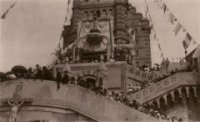
- Juin 1931, le parvis de Notre-Dame de la Garde pendant les fêtes du couronnement de la statue de la Vierge
Whilst these legal steps were in progress, the celebrations for the crowning of the statue of
Notre-Dame de la Garde had drawn to Marseilles, for four days in June1931, a host of 49 bishops and 300,000 people. Pope Pius XI had sent as legate, to preside over these celebrations, Cardinal
Louis Maurin, Archbishop of Lyons and former rector of Notre-Dame de la Garde. The date for these festivites had been chosen to mark the 15th centenary of the œcumenic Council of Ephesus
(June 431) which had declared that the Virgin Mary could be called «Mother of God»

